The sweat running down your brow, as you gently puff into the blowpipe attached to the amorphous blob of molten glass at the end of said pipe – which is inserted in a furnace – not from the 2,300-degree fire in front of you – it’s from your nerves! You just don’t want to make a “mistake” on your very first piece of (what will assuredly be museum-worthy) art glass. Phew.
The Corning Museum of Glass (located, as its name cunningly suggests, in Corning, NY, and referred to as CMoG), is a Mecca for all things glass. And after one experience within the campus footprint, the Make Your Own Glass experience, I was hooked. And so will you be, if you make the pilgrimage to this highly fascinating and educational Mecca.

The original CMoG structure, designed in 1951 by the renowned architect Wallace K. Harrison, has long been home to an exciting exhibit space, a formidable research library, a cutting-edge education center, and more. Today, however, having expanded dramatically over the years, the entire campus comprises a unique collection of award-winning, modern, glass structures, stretching over 10 acres and housing even more glass and glass-related archives, exhibition, and participatory programs.

The newest expansion includes The Studio, a state-of-the-art center for glass, glass, and more glass, including the Make Your Own Glass workshop, allowing devotees of silica and sand to explore not only glass blowing (make a flower, a pumpkin, a Christmas ornament!), but also fusing, sandblasting, flameworking, and other glass arts. (Prices for these hands-on experiences range from $15 to $150.)

The Studio, established in 1996 by CMoG, was then a 24,000-square-foot facility that soon garnered an international reputation and became a sought-after destination, offering instruction across a spectrum of techniques and skill levels, as well as residencies for artists, and rentals of furnace, kiln, and cold-working space and equipment. Enter StudioNEXT, a visionary project created to expand the facility’s footprint to a staggering 60,000 square feet and which transforms the already exciting and educational experience to a preeminent global center for artists and students of glass. The $55.3 million project is CMoG’s largest and most forward-looking initiative to date, underscoring the Museum’s commitment to glass as a major medium for contemporary artistic expression, doubling down on the Museum’s support for artists and designers who are innovating in glass.
The Studio offers instruction across a spectrum of techniques and skill levels, residencies for artists, and rentals of furnace, kiln, and cold-working space and equipment. By expanding and enhancing the infrastructure, this expansion creates the only facility in North America that can accommodate large-scale works in cast glass; deepens glassmaking educational programs for students of all levels; offers expanded residency opportunities; and serves many more visitors each day.
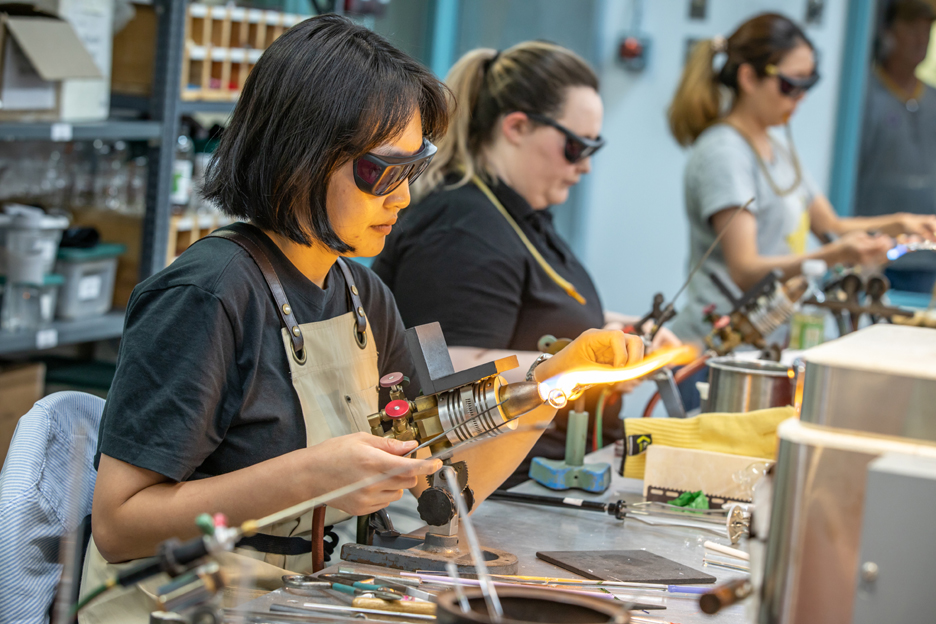
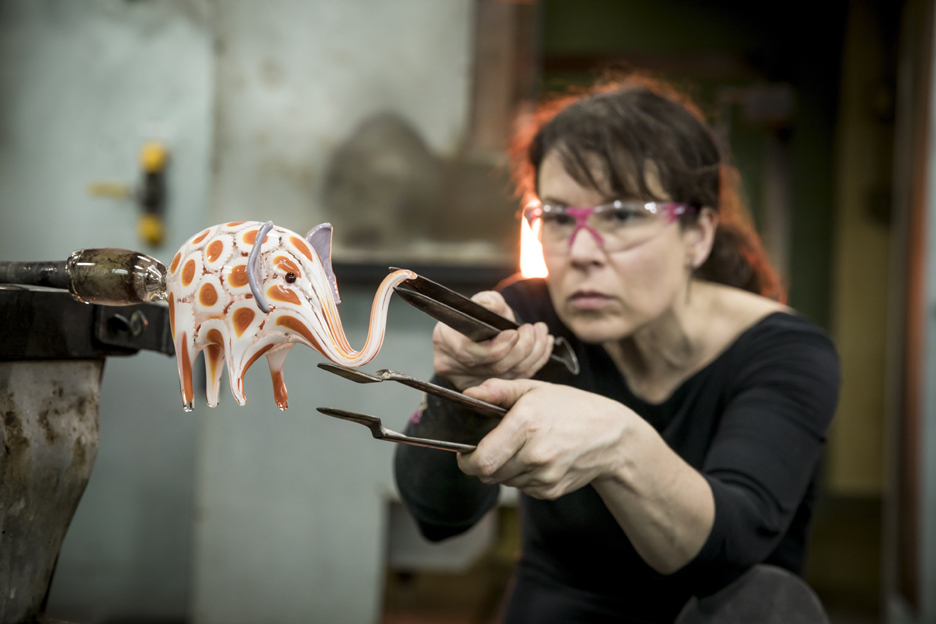
Over the years, CMoG has also assumed stewardship of the illustrious and historic Steuben art glass brand, and Corning still produces some select Steuben pieces; proceeds from the sale of Steuben pieces benefit the educational mission of the non-profit Museum. The historic ventilator building Steuben once inhabited, located on the CMoG campus, was renovated and repurposed as the 500-seat Amphitheater Hot Shop – one of the world’s largest space in which to watch live glassblowing demonstrations. Although no longer under the umbrella of the Corning Incorporated brand, the household name Pyrex, also, has its roots in the Corning community.
The Rakow Research Library includes world’s foremost archive and reference collection on the history of glassmaking. A center for scholarship, CMoG publishes glass-focused periodicals, books, DVDs, and exhibition catalogs.
Another jewel in the crown of CMoG is the collection itself, home to more than 50,000 extraordinary works in glass. Spanning the globe and encompassing more than 3,500 years of human ingenuity, the collection includes masterpieces from the great civilizations of ancient Egypt, Greece, and Rome, as well as glass from other parts of Europe, the Far East/Asia, the Americas, and other far-flung melting pots of humanity.
Some of the highlights of the Museum’s 35 centuries of glass include:
- One of the earliest known glass portraits, a rare ancient glass sculpture of an Egyptian king, dating from the late 18th Dynasty, about 1450-1400 B.C.
- The earliest known example of an Islamic drinking horn (only two others are known)
- The Behaim beaker, a Venetian enameled glass that commemorates a marriage heldin 1495.
- One of the earliest known pieces of American glass, a covered tumbler produced at the factory of John Frederick Amelung.
Highlights of the contemporary art and design wing include:
- “The Continuous Mile,” a mile-long sculpture composed of over 4.5 million glass beads created by Liza Lou and more than 50 bead workers in KwaZulu-Natal, South Africa.
- “Virtue of Blue,” a self-sustaining chandelier constructed completely out of blue solar panel butterflies
Some of my favorites among the more modern pieces include:
- Celebrated artist Lino Tagliapietra’s “Endeavor” installation is a seemingly in-flight flock of birds, or a graceful, gliding school of fish, or even a waltzing fleet of boats. It features a dozen-plus, colorful,glass swirls and swooshes, suspended from the ceiling. The viewer is metaphorically invited into it, to experience its movement, grace, weightlessness, and elegance
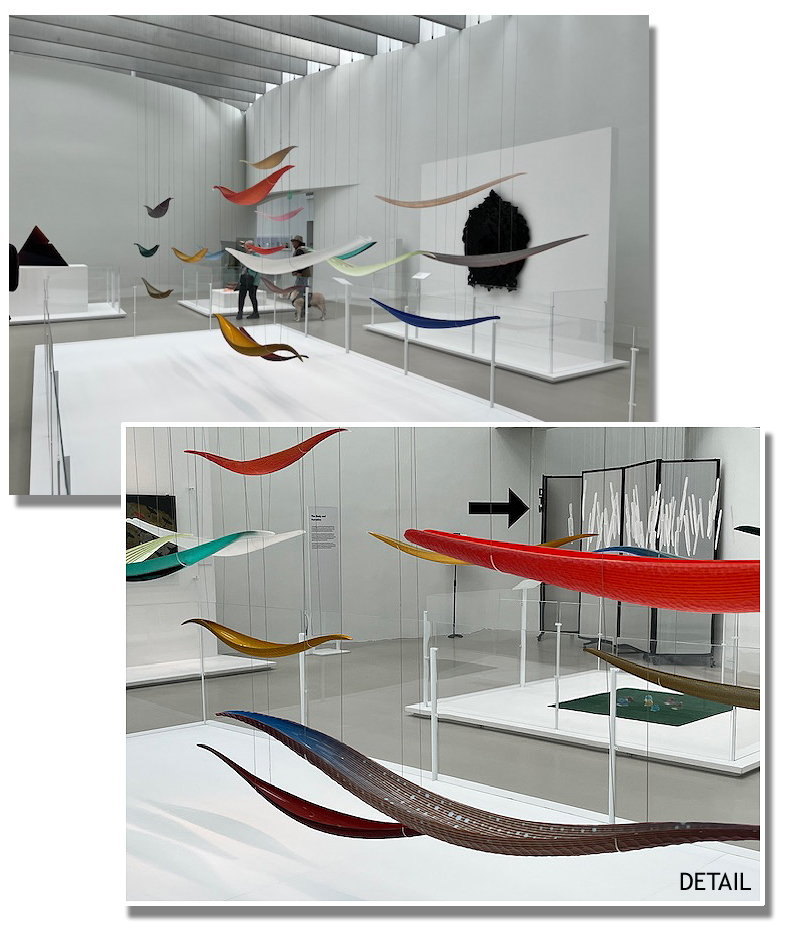
Photo courtesy of the author.
- Also suspended from the ceiling is Silvia Levenson’s “It’s Raining Knives,” an arresting forest of cast-glass knives, which are ground and polished to many a striking point!
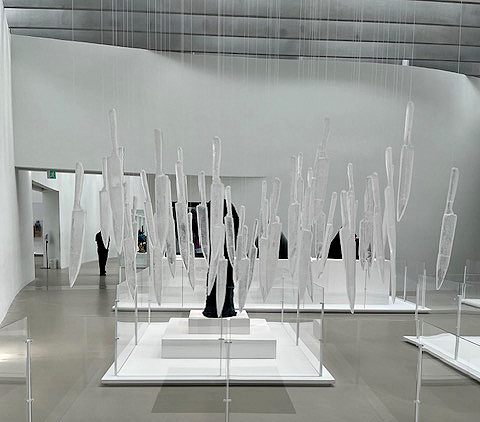
- “Forest Glass” by Katherine Gray is composed of some 2,000 found glass objects – mostly tumblers of one form or another – that are arranged on clear shelves, forming three “trees,” recognizable by their brownish”trunks” and greenish, “leafy” canopies. The didactics adjacent to the piece state that the “The title refers to the Waldglas, translated from German as ‘forest glass,’ the typically dark green and brown glass made during the Middle Ages in northern and central Europe. The wood burned to fuel glass furnaces resulted in widespread deforestation. Here, Katherine Gray re-created trees out of the material that destroyed them – ‘recycling’ the trees with recycled glass.”
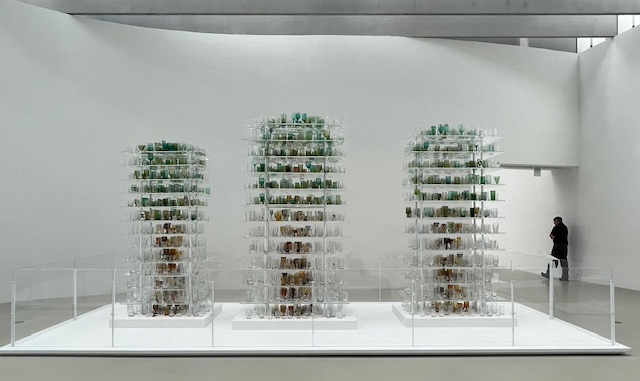
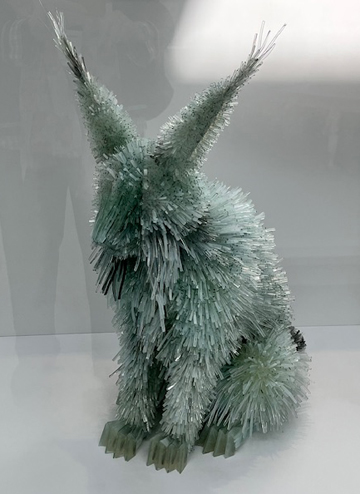
- Set against a backdrop (on the floor) of a flattened black and white schematic of the world, “Global Cities,” by Norwood Viviano, tells the story of global population change through the individual histories of 33 cities around the world.The bright blue top-like floating forms correlate to populations. It is a striking and evocative piece.
- Beth Lipman’s “All in All” is a typical tablescape for which the artist is known-blown glass forms are the fare of the tabletop – pre-historic plants comprise the design.
- “Lynx after a Sketchbook Page by Albrecht Dürer,” by Polish-born Marta Klonoska, employs thousands of pieces of cut glass, creating the “fur” of the lynx. He looks so cute you might want to pet him, but this lynx is more like a porcupine…and hands off, anyhow – you’re in a museum!
- A charming and inspired work, “108 Meditations in Saffron” by David Chatt is a vitrine assemblage of found objects, covered in intricate fiery-orange beading. Everyday objects – found tchotchkes, if you will – form the basis of this arresting agglomeration of mere stuff!

CMoG is committed to exploring glass in many ways and recently mounted an outstanding show, “Disclosure: The Whiteness of Glass,” which explored subtle racism within this ivory-tower pursuit. It was riveting and as a viewer, you were forced to ask uncomfortable questions and explore emotions.
Additionally, CMoG has a truly fabulous, 18,000-square-feet gift shop – think fine art objets along with gewgaws, fanciful “stuff,” sparkling jewelry, and utilitarian must-haves – that vends everything from books about glass, to ornaments, to functional and stunning or mundane and utilitarian tools. For your comfort, as well, there is a very decent restaurant and other visitor amenities.
Additional info: home.cmog.org
© 2024 Ruth J. Katz All Rights Reserved



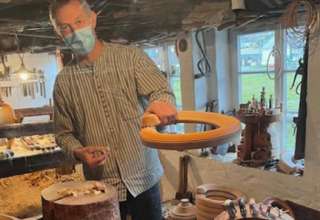

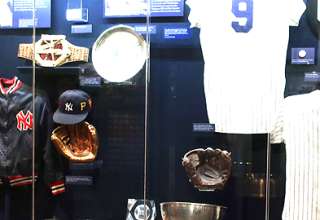



















Alison
February 20, 2025 at 11:07 pm
Hii
Do you accept guest posts on travelingboy.com?